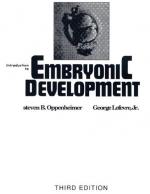|
This section contains 3,636 words (approx. 13 pages at 300 words per page) |

|
All embryonic structures are derived from a single cell formed by the union of two gametes. Every individual organism began as a single cell, which divided and differentiated into various types of cells that make up the diverse tissues and complex structures found in the adult. Ontogeny, or the development of an organism from fertilization to adult, begins with the fusion of two cells, the sperm and egg. The sperm and egg are haploid cells formed through the process of meiosis. The haploid cells have no function outside of their involvement in reproduction.
Many invertebrates have isolecithal eggs (yolk is evenly distributed throughout the egg). These eggs have relatively little yolk and various patterns of holoblastic cleavage (the cells divide completely and evenly). The arthropod egg has a moderate amount of yolk, concentrated in the egg's center. The eggs of amphibians and cartilaginous fishes have a...
|
This section contains 3,636 words (approx. 13 pages at 300 words per page) |

|


